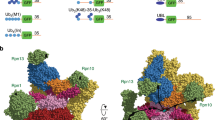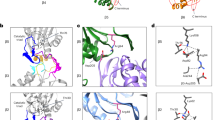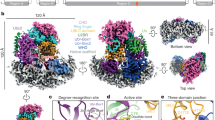Abstract
The eukaryotic 26S proteasome controls cellular processes by degrading specific regulatory proteins. Most proteins are targeted for degradation by a signal or degron that consists of two parts: a proteasome-binding tag, typically covalently attached polyubiquitin chains, and an unstructured region that serves as the initiation region for proteasomal proteolysis. Here we have characterized how the arrangement of the two degron parts in a protein affects degradation. We found that a substrate is degraded efficiently only when its initiation region is of a certain minimal length and is appropriately separated in space from the proteasome-binding tag. Regions that are located too close or too far from the proteasome-binding tag cannot access the proteasome and induce degradation. These spacing requirements are different for a polyubiquitin chain and a ubiquitin-like domain. Thus, the arrangement and location of the proteasome initiation region affect a protein's fate and are important in selecting proteins for proteasome-mediated degradation.
This is a preview of subscription content, access via your institution
Access options
Subscribe to this journal
Receive 12 print issues and online access
$259.00 per year
only $21.58 per issue
Buy this article
- Purchase on Springer Link
- Instant access to full article PDF
Prices may be subject to local taxes which are calculated during checkout






Similar content being viewed by others
References
Pickart, C.M. Back to the future with ubiquitin. Cell 116, 181–190 (2004).
Prakash, S., Tian, L., Ratliff, K.S., Lehotzky, R.E. & Matouschek, A. An unstructured initiation site is required for efficient proteasome-mediated degradation. Nat. Struct. Mol. Biol. 11, 830–837 (2004).
Takeuchi, J., Chen, H. & Coffino, P. Proteasome substrate degradation requires association plus extended peptide. EMBO J. 26, 123–131 (2007).
Schrader, E.K., Harstad, K.G. & Matouschek, A. Targeting proteins for degradation. Nat. Chem. Biol. 5, 815–822 (2009).
Thrower, J.S., Hoffman, L., Rechsteiner, M. & Pickart, C.M. Recognition of the polyubiquitin proteolytic signal. EMBO J. 19, 94–102 (2000).
Deveraux, Q., Ustrell, V., Pickart, C. & Rechsteiner, M. A 26 S protease subunit that binds ubiquitin conjugates. J. Biol. Chem. 269, 7059–7061 (1994).
Lam, Y.A., Lawson, T.G., Velayutham, M., Zweier, J.L. & Pickart, C.M. A proteasomal ATPase subunit recognizes the polyubiquitin degradation signal. Nature 416, 763–767 (2002).
Husnjak, K. et al. Proteasome subunit Rpn13 is a novel ubiquitin receptor. Nature 453, 481–488 (2008).
Elsasser, S. & Finley, D. Delivery of ubiquitinated substrates to protein-unfolding machines. Nat. Cell Biol. 7, 742–749 (2005).
Finley, D. Recognition and processing of ubiquitin-protein conjugates by the proteasome. Annu. Rev. Biochem. 78, 477–513 (2009).
Hiyama, H. et al. Interaction of hHR23 with S5a. The ubiquitin-like domain of hHR23 mediates interaction with S5a subunit of 26 S proteasome. J. Biol. Chem. 274, 28019–28025 (1999).
Elsasser, S. et al. Proteasome subunit Rpn1 binds ubiquitin-like protein domains. Nat. Cell Biol. 4, 725–730 (2002).
Saeki, Y., Sone, T., Toh-e, A. & Yokosawa, H. Identification of ubiquitin-like protein-binding subunits of the 26S proteasome. Biochem. Biophys. Res. Commun. 296, 813–819 (2002).
Prakash, S., Inobe, T., Hatch, A.J. & Matouschek, A. Substrate selection by the proteasome during degradation of protein complexes. Nat. Chem. Biol. 5, 29–36 (2009).
Johnson, E.S., Gonda, D.K. & Varshavsky, A. cis-trans recognition and subunit-specific degradation of short-lived proteins. Nature 346, 287–291 (1990).
Hochstrasser, M. & Varshavsky, A. In vivo degradation of a transcriptional regulator: the yeast alpha 2 repressor. Cell 61, 697–708 (1990).
Klotzbücher, A., Stewart, E., Harrison, D. & Hunt, T. The 'destruction box' of cyclin A allows B-type cyclins to be ubiquitinated, but not efficiently destroyed. EMBO J. 15, 3053–3064 (1996).
Verma, R., McDonald, H., Yates, J.R. & Deshaies, R.J. Selective degradation of ubiquitinated Sic1 by purified 26S proteasome yields active S phase cyclin-Cdk. Mol. Cell 8, 439–448 (2001).
Stack, J.H., Whitney, M., Rodems, S.M. & Pollok, B.A. A ubiquitin-based tagging system for controlled modulation of protein stability. Nat. Biotechnol. 18, 1298–1302 (2000).
Komander, D. et al. Molecular discrimination of structurally equivalent Lys 63-linked and linear polyubiquitin chains. EMBO Rep. 10, 466–473 (2009).
Saeki, Y. et al. Lysine 63-linked polyubiquitin chain may serve as a targeting signal for the 26S proteasome. EMBO J. 28, 359–371 (2009).
Watkins, J.F., Sung, P., Prakash, L. & Prakash, S. The Saccharomyces cerevisiae DNA repair gene RAD23 encodes a nuclear protein containing a ubiquitin-like domain required for biological function. Mol. Cell. Biol. 13, 7757–7765 (1993).
Schauber, C. et al. Rad23 links DNA repair to the ubiquitin/proteasome pathway. Nature 391, 715–718 (1998).
Johnston, J.A., Johnson, E.S., Waller, P.R. & Varshavsky, A. Methotrexate inhibits proteolysis of dihydrofolate reductase by the N-end rule pathway. J. Biol. Chem. 270, 8172–8178 (1995).
Verhoef, L.G. et al. Minimal length requirement for proteasomal degradation of ubiquitin-dependent substrates. FASEB J. 23, 123–133 (2009).
Politou, A.S., Gautel, M., Pfuhl, M., Labeit, S. & Pastore, A. Immunoglobulin-type domains of titin: same fold, different stability? Biochemistry 33, 4730–4737 (1994).
Rief, M., Gautel, M., Oesterhelt, F., Fernandez, J.M. & Gaub, H.E. Reversible unfolding of individual titin immunoglobulin domains by AFM. Science 276, 1109–1112 (1997).
Improta, S., Politou, A.S. & Pastore, A. Immunoglobulin-like modules from titin I-band: extensible components of muscle elasticity. Structure 4, 323–337 (1996).
von Castelmur, E. et al. A regular pattern of Ig super-motifs defines segmental flexibility as the elastic mechanism of the titin chain. Proc. Natl. Acad. Sci. USA 105, 1186–1191 (2008).
Yang, T.T., Cheng, L. & Kain, S.R. Optimized codon usage and chromophore mutations provide enhanced sensitivity with the green fluorescent protein. Nucleic Acids Res. 24, 4592–4593 (1996).
Adams, S.R. et al. New biarsenical ligands and tetracysteine motifs for protein labeling in vitro and in vivo: synthesis and biological applications. J. Am. Chem. Soc. 124, 6063–6076 (2002).
Beskow, A. et al. A conserved unfoldase activity for the p97 AAA-ATPase in proteasomal degradation. J. Mol. Biol. 394, 732–746 (2009).
Tian, L., Holmgren, R.A. & Matouschek, A. A conserved processing mechanism regulates the activity of transcription factors Cubitus interruptus and NF-κB. Nat. Struct. Mol. Biol. 12, 1045–1053 (2005).
Larsen, C.N. & Finley, D. Protein translocation channels in the proteasome and other proteases. Cell 91, 431–434 (1997).
Baumeister, W., Walz, J., Zühl, F. & Seemüller, E. The proteasome: paradigm of a self-compartmentalizing protease. Cell 92, 367–380 (1998).
Keiler, K.C., Waller, P.R. & Sauer, R.T. Role of a peptide tagging system in degradation of proteins synthesized from damaged messenger RNA. Science 271, 990–993 (1996).
Gottesman, S., Roche, E., Zhou, Y. & Sauer, R.T. The ClpXP and ClpAP proteases degrade proteins with carboxy-terminal peptide tails added by the SsrA-tagging system. Genes Dev. 12, 1338–1347 (1998).
Flynn, J.M., Neher, S.B., Kim, Y.I., Sauer, R.T. & Baker, T.A. Proteomic discovery of cellular substrates of the ClpXP protease reveals five classes of ClpX-recognition signals. Mol. Cell 11, 671–683 (2003).
Gonzalez, M., Frank, E.G., Levine, A.S. & Woodgate, R. Lon-mediated proteolysis of the Escherichia coli UmuD mutagenesis protein: in vitro degradation and identification of residues required for proteolysis. Genes Dev. 12, 3889–3899 (1998).
Yamada-Inagawa, T., Okuno, T., Karata, K., Yamanaka, K. & Ogura, T. Conserved pore residues in the AAA protease FtsH are important for proteolysis and its coupling to ATP hydrolysis. J. Biol. Chem. 278, 50182–50187 (2003).
Hinnerwisch, J., Fenton, W.A., Furtak, K.J., Farr, G.W. & Horwich, A.L. Loops in the central channel of ClpA chaperone mediate protein binding, unfolding, and translocation. Cell 121, 1029–1041 (2005).
Martin, A., Baker, T.A. & Sauer, R.T. Diverse pore loops of the AAA+ ClpX machine mediate unassisted and adaptor-dependent recognition of ssrA-tagged substrates. Mol. Cell 29, 441–450 (2008).
Zhang, F. et al. Mechanism of substrate unfolding and translocation by the regulatory particle of the proteasome from Methanocaldococcus jannaschii. Mol. Cell 34, 485–496 (2009).
Djuranovic, S. et al. Structure and activity of the N-terminal substrate recognition domains in proteasomal ATPases. Mol. Cell 34, 580–590 (2009).
Miller, W.G. & Goebel, C.V. Dimensions of protein random coils. Biochemistry 7, 3925–3935 (1968).
Heessen, S., Masucci, M.G. & Dantuma, N.P. The UBA2 domain functions as an intrinsic stabilization signal that protects Rad23 from proteasomal degradation. Mol. Cell 18, 225–235 (2005).
Levchenko, I., Grant, R.A., Flynn, J.M., Sauer, R.T. & Baker, T.A. Versatile modes of peptide recognition by the AAA+ adaptor protein SspB. Nat. Struct. Mol. Biol. 12, 520–525 (2005).
McGinness, K.E., Bolon, D.N., Kaganovich, M., Baker, T.A. & Sauer, R.T. Altered tethering of the SspB adaptor to the ClpXP protease causes changes in substrate delivery. J. Biol. Chem. 282, 11465–11473 (2007).
Rood, J.I., Laird, A.J. & Williams, J.W. Cloning of the Escherichia coli K-12 dihydrofolate reductase gene following mu-mediated transposition. Gene 8, 255–265 (1980).
Saeki, Y., Isono, E. & Toh-E, A. Preparation of ubiquitinated substrates by the PY motif-insertion method for monitoring 26S proteasome activity. Methods Enzymol. 399, 215–227 (2005).
Acknowledgements
We thank S. Elsasser (Harvard University Medical School), D. Finley (Harvard University Medical School), B.S. Glick (University of Chicago) and Y. Saeki (Tokyo Metropolitan Institute of Medical Science) for providing plasmids and yeast strains and members of the Matouschek lab for advice and comments. The authors greatly appreciate and gratefully acknowledge N. Nukina (RIKEN) for his support and the use of his laboratory equipment. We also thank G. Leigh for editing the manuscript. The work was supported by grants R01GM063004 and U54CA143869 from the US National Institutes of Health, by Ministry of Education, Culture, Sports, Science and Technology of Japan Grant-in-Aid 22770137 (T.I.) and by the Robert H. Lurie Comprehensive Cancer Center at Northwestern University. T.I. also gratefully acknowledges a Japan Society for the Promotion of Science Postdoctoral Fellowship for Research Abroad and the RIKEN Special Postdoctoral Researchers Program.
Author information
Authors and Affiliations
Contributions
T.I., S.F., S.P. and A.M. designed and interpreted the experiments and wrote the manuscript. T.I., S.F. and S.P. performed the experiments.
Corresponding author
Ethics declarations
Competing interests
The authors declare no competing financial interests.
Supplementary information
Supplementary Text and Figures
Supplementary Figures 1–5 and Supplementary Methods (PDF 1163 kb)
Rights and permissions
About this article
Cite this article
Inobe, T., Fishbain, S., Prakash, S. et al. Defining the geometry of the two-component proteasome degron. Nat Chem Biol 7, 161–167 (2011). https://doi.org/10.1038/nchembio.521
Received:
Accepted:
Published:
Issue Date:
DOI: https://doi.org/10.1038/nchembio.521
This article is cited by
-
Stable maternal proteins underlie distinct transcriptome, translatome, and proteome reprogramming during mouse oocyte-to-embryo transition
Genome Biology (2023)
-
Degron masking outlines degronons, co-degrading functional modules in the proteome
Communications Biology (2022)
-
The proteasome 19S cap and its ubiquitin receptors provide a versatile recognition platform for substrates
Nature Communications (2020)
-
Structure of E3 ligase E6AP with a proteasome-binding site provided by substrate receptor hRpn10
Nature Communications (2020)
-
The Cdc48 unfoldase prepares well-folded protein substrates for degradation by the 26S proteasome
Communications Biology (2019)



